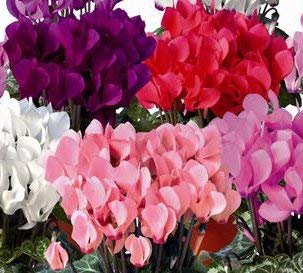The wild species from which florists’ cyclamen are derived is Cyclamen persicum. Many spring visitors to the Mediterranean islands of Cyprus, Rhodes and (Eastern) Crete are likely to have seen it in flower there but it grows also (together with a few other places) on the islands and coastal areas of the Eastern Aegean and around the North Eastern corner of the Mediterranean from southern Turkey to northern Israel. It can grow in great drifts of thousands of plants, the commonest flower around, and fill the air with a sweet scent. However, Cyclamen persicum is only one of around 23 species, some of them frost hardy, one or another of which can be in flower from late summer until late spring..  Florists’ cyclamen
Florists’ cyclamen
Buying or being given one of these as a present is most people’s first encounter with a cyclamen are cultivars of the wild Cyclamen persicum and are sold in millions all over the world. Coming into flower during the winter in a range of colour shades from white through pink to red they are hugely popular as houseplants around December/January in the northern hemisphere. They are also used as bedding plants, particularly around the Mediterranean, and in window boxes in northern European cities. Unfortunately, they are not completely frost hardy which restricts their use as garden plants in areas with hard winters. Fortunately, species such as Cyclamen coum and Cyclamen hederifolium can be used that.  Florists’ cyclamen have been bred over more than 150 years. Initially selected for a wider range of colours, based on the white and pink seen in wild Cyclamen persicum and for larger flowers. At the same time different petal shapes arose, flattened (the wild version is twisted), fringed (toothed edge) double and others.
Florists’ cyclamen have been bred over more than 150 years. Initially selected for a wider range of colours, based on the white and pink seen in wild Cyclamen persicum and for larger flowers. At the same time different petal shapes arose, flattened (the wild version is twisted), fringed (toothed edge) double and others.  More recently these efforts have extended to re-introducing scent, lost during the development of larger plants, increasing the extent and intensity of leaf patterning and developing more sizes, so they are now available from tiny, through small, medium and large, to giant (Micro, Mini,midi maxi,magnum..
More recently these efforts have extended to re-introducing scent, lost during the development of larger plants, increasing the extent and intensity of leaf patterning and developing more sizes, so they are now available from tiny, through small, medium and large, to giant (Micro, Mini,midi maxi,magnum..  Perhaps you have a cyclamen on the windowsill which is looking a bit tired but it was given to you by someone special or you particularly like it or you forgot to water it and when you remembered the leaves were a bit yellow and didn’t turn green again. Don’t despair! The wild plants are long lived, resting through the long dry Mediterranean summer and growing again once the winter rains start. The houseplants will respond the same way. Water regularly until spring, not too much – more cyclamen die from over watering than ever die of drought, then reduce and leave virtually dry over the summer. Start watering again in early autumn and your plant should grow and flower again.
Perhaps you have a cyclamen on the windowsill which is looking a bit tired but it was given to you by someone special or you particularly like it or you forgot to water it and when you remembered the leaves were a bit yellow and didn’t turn green again. Don’t despair! The wild plants are long lived, resting through the long dry Mediterranean summer and growing again once the winter rains start. The houseplants will respond the same way. Water regularly until spring, not too much – more cyclamen die from over watering than ever die of drought, then reduce and leave virtually dry over the summer. Start watering again in early autumn and your plant should grow and flower again.  thanks to sharing for your great post of cyclamen plants.. very well done.my dear friend.. @ctrl-alt-nwo
thanks to sharing for your great post of cyclamen plants.. very well done.my dear friend.. @ctrl-alt-nwo
Sort: Trending
[-]
sadkitten (-6)(1) 7 years ago
$0.00
Reveal Comment